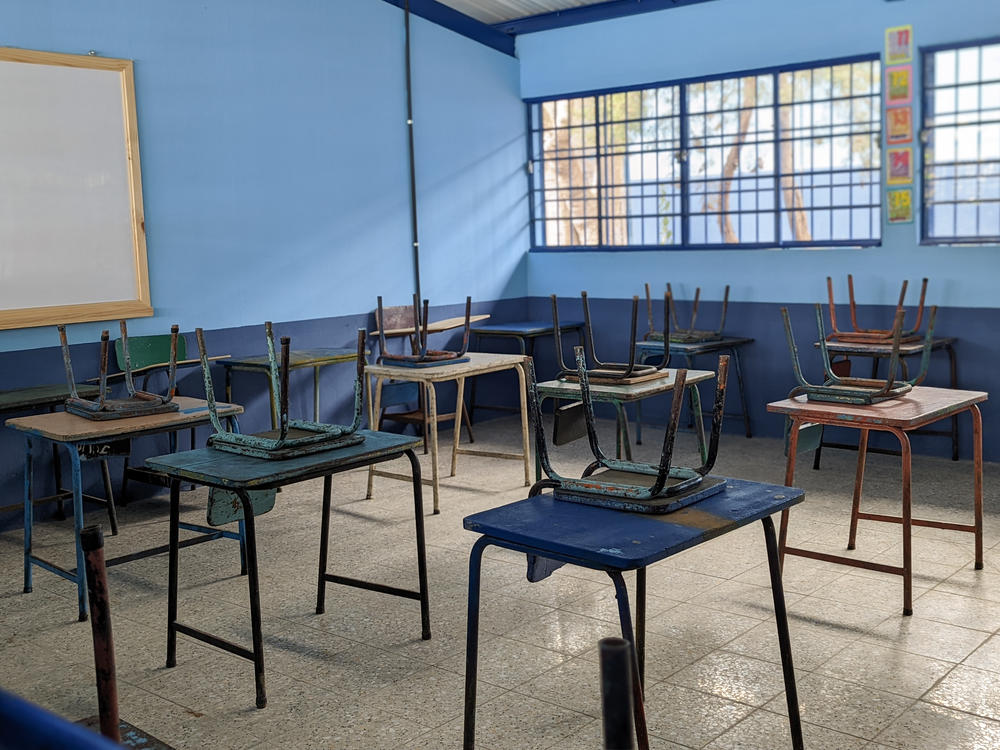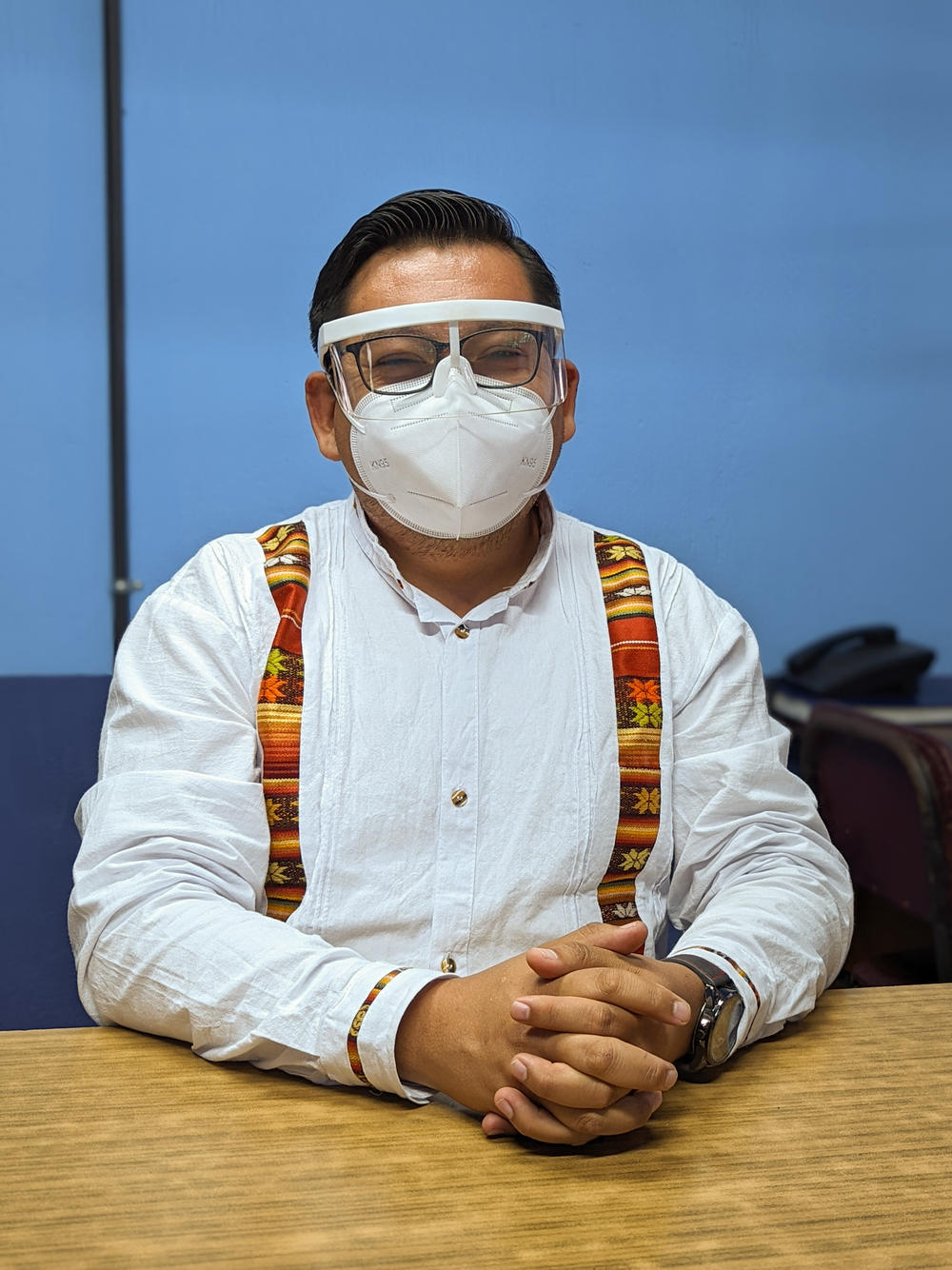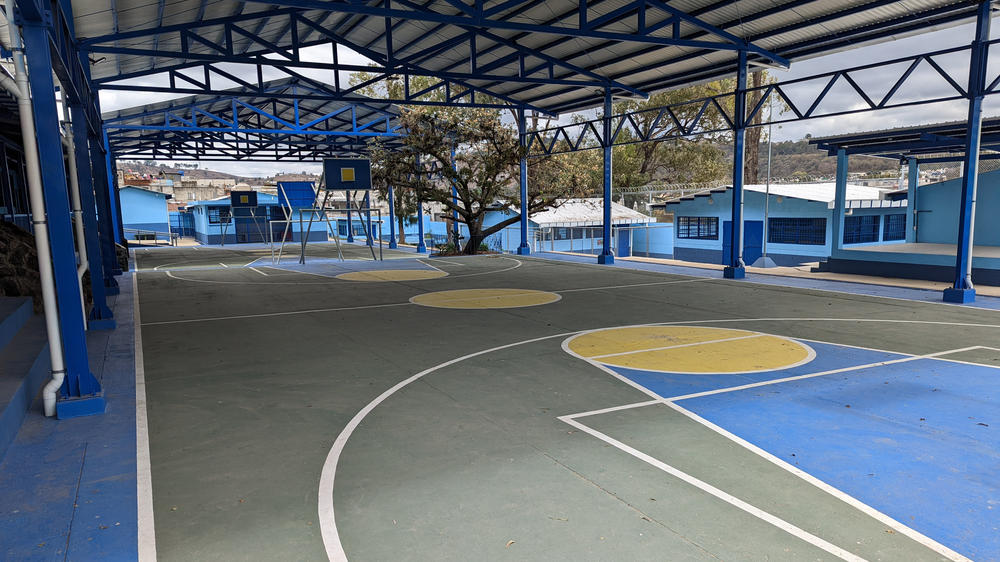Section Branding
Header Content
Why lots of kids still aren't back in school in Guatemala
Primary Content
The doors of the Hermogenes Gonzalez Mejia school in Guatemala City were propped wide open. The interior smelled of fresh paint and cleaning supplies. Inside each classroom, tiny desks were lined up with chairs neatly stacked on top. Two large basketball courts in the outdoor courtyard looked pristine.
All that was missing was students.
After two years of remote learning, the time had come to get them back inside. "They need to interact with their classmates and try to find some kind of normalcy," said Oscar Fernando Lopez Polanco, director of the Mejia school, while prepping in his office for an assembly in mid-February to announce reopening plans. At the entrance, a teacher welcomed parents and their children by taking their temperature, squirting sanitizer on their hands, and spraying them from head to toe with disinfectant – a practice that has become common in Guatemala as part of the efforts to mitigate the spread of the virus , despite having no proven benefits.
It's a moment many parents and children across Guatemala are still waiting for. Due to the pandemic, millions of students in the country have been stuck in remote learning since March 2020. The generally run-down conditions in many school buildings, which had been badly in need of repair long before the arrival of COVID-19, have government officials wary about the safety of returning to in-person learning.
Why it's been hard to reopen schools
Internationally, there's been a significant push to return students to classrooms. In a 2021 report, the U.N. said schools are not associated with increased COVID-19 transmission but rather reflect the level of community transmission. The World Health Organization has urged governments to consider closing schools only when there are no other alternatives.
But in Guatemala, the government has stalled plans for reopening. During 2021, the government paid to renovate 554 public schools that required general repairs even before the pandemic.
However, there are close to 9,000 that lack safe water, electricity or other necessities. Veronica Spross, executive director at Entrepreneurs for Education, a Guatemala-based organization that promotes long-term solutions for the country's education system, says that's no excuse for delaying the reopening any longer. "There's different institutions like churches, private businesses, small shops, among others, that can help schools get ready," she says. Donations from the community could get necessary resources in place faster.
Red light, yellow light ...
Education advocates are also imploring the government to rethink the traffic light system that is used to manage the pandemic. Each municipality is assigned a color that determines its restrictions and permissions. There are currently 138 municipalities in the red zone, which are not allowed to hold in-person classes in public schools. But private schools, which tend to have more resources, have been allowed to bring students back as long as they meet the health guidelines.
Lopez Polanco's municipality recently shifted from red to orange thanks to an adjustment made in mid-February that takes into account vaccination rates in determining each area's color. Because more than 80% of his municipality has at least one dose of the vaccine, he's now allowed to reopen his school at a limited capacity, if parents consent and the school can meet the government's health guidelines.
But that's no easy feat. Guidelines include masks, face shields for staff, open windows for natural ventilation in classrooms, strict physical distancing, and stations with soap and water or hand sanitizer in every classroom. Staff are required to clean each room after each class, and the number of children allowed inside at the same time is limited.
Meeting these guidelines would have been impossible in March 2020, Lopez Polanco says. "We lacked drainage systems because they were collapsed by tree roots. We had water supply problems because the pump was no longer working, the electrical system was failing us, there were burned out bulbs in some classrooms," he says.
With the school unoccupied during the pandemic, Lopez Polanco made repairs a priority. Through a combination of good fortune and helpful contacts, the building received nearly $1 million in government funds for a makeover that included a new roof and new windows, a renovated kitchen and an upgraded electrical system. Plus, there's now a civic plaza for hosting assemblies and a parking lot. "What I have of the old building is practically the walls," he says.
These improvements made the school easier to reopen, but more funding is still needed for day-to-day operations. Lopez Polanco only gets around the equivalent of $5 per child for school supplies, which must now include items such as disinfectant, hand sanitizer and masks.
He insists that these problems can't keep kids out of school any longer, especially when so many of them are lagging behind.
What students have lost
"As a teacher, I can say that COVID is already taking its toll [on education]," he said. "I have kids coming into third grade with reading problems, unable to write. And that's our challenge now. What we need – other than health supplies – is bravery from parents and staff to come to school. Because we're basically creating an entirely new school system from what we were used to."
Although some parents are still wary about their kids getting sick, most of them are open to sending them to school. Only a couple families opted out of in-person plans. As of last month, Lopez Polanco's school started operating on a hybrid system — both in-person and virtually — managed through COVID bubbles, where kids are assigned to groups (based on the square footage of their classroom) and each group attends school on different days of the week.
First-grade teacher Boris Martinez has seen slower progress at his school, which sits about 150 miles away from the capital city in Izabal, a rural area. For the entirety of 2021 and the beginning of this year, his municipality was in the red zone, so he could only teach remotely.
Some of his students don't have access to technology for virtual learning. Over the last two years, he's found creative ways to teach despite the trying circumstances. He even set up a socially-distanced classroom on the porch of his home for clusters of students who didn't have computers or phones to use for virtual learning.
"It was the only way I could get kids to learn to read and write," he said, "But [like them], there are thousands of children in this country that aren't learning because they are poor. And that's not their fault."
Martinez, along with the school's administration, were so desperate to get the students in the classrooms that they collected signatures from parents who said they wanted the school to reopen. Their school met all the health guidelines and even has some pandemic-related supplies, mostly donated, that are luxuries for other schools in the country: thermometers and electric hand sanitizer dispensers. He argued that if private schools could open in the red-zone, there should be no reason why his school couldn't. So the school opened despite government regulations but with parents' approval. He didn't think anyone would report him and the other teachers.
Soon after, however, a WhatsApp message from their union started circulating warning school administrators that they could face penalties if they kept their schools open against the law. So Martinez soon brought students back to the porch of his home and waited for the municipality's COVID cases to decline.
On March 19, an update to the traffic light system finally brought Morales, Izabal, to the orange zone, making it possible to open school buildings again without the risk of penalties. "The common denominator in this community is that people want their kids to learn," Martinez says. "Now the real question is, and I can't really answer that, who doesn't want that? This disease or the government?"
He worries that a rise in cases could bring his municipality back to the red zone and send the kids to remote learning once more.
Copyright 2022 NPR. To see more, visit https://www.npr.org.



